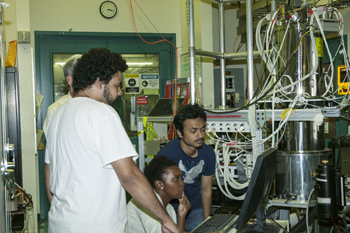LLNL hosts plasma physics summer school
 (Download Image)
L-R: Jerry Clark (Florida A&M), Professor Charles Weatherford (Florida A&M), Staci Brown (Florida A&M) and Sajan Shresthra (Benedict College) study spectra at LLNL's Electron Beam Ion Trap Facility.
(Download Image)
L-R: Jerry Clark (Florida A&M), Professor Charles Weatherford (Florida A&M), Staci Brown (Florida A&M) and Sajan Shresthra (Benedict College) study spectra at LLNL's Electron Beam Ion Trap Facility.
Organized by physicists Peter Beiersdorfer and Kennedy Reed, the school was one of several LLNL summer projects of the "Consortium on Experimental and Computational Studies of Matter Under Extreme Environments." This consortium, supported by the National Nuclear Security Administration (NNSA), is comprised of LLNL, Tuskegee University, Florida A&M University and Benedict College, and stems from a NNSA initiative to involve faculty and students at HBCUs in collaborative work with DOE national laboratories.
"A major goal of the consortium is to enhance the training of students and help develop a future workforce that will have critical skills aligned with NNSA mission needs," said Kennedy Reed, the LLNL principal investigator for the consortium. "Exposure to LLNL facilities and scientists, and hands-on experience within LLNL research programs are essential elements of our strategy for achieving this goal."
These elements were heavily present in the plasma physics summer school. Daily lectures introduced the students to the underlying atomic physics needed to understand spectra, and special seminars by LLNL scientists active in high-temperature plasma science provided insight into experimental and computational aspects of this research. Students toured relevant research facilities at the Lab to learn about experimental and engineering aspects of dealing with ionized matter, and participated in ongoing research activities at the Electron Beam Ion Trap Facility. A night of observing at the Lick Observatory was an additional highlight for the participants.
"My experience in the program has definitely exposed me and piqued my interest to many areas of plasma physics that I wasn't privy to before," said Staci Brown, program participant and student at Florida A&M. "As an experimentalist in the area of laser spectroscopy, the tours of the NIF and the Jupiter laser facilities were really neat, and the knowledge that I have gained during the lecture series will have an impact on my research as a graduate student."
Contact
Breanna Bishop[email protected]
925-423-9802
Related Links
Historically Black Colleges and UniversitiesTags
DiversityAcademic Engagement
STEM
NNSA
Physical and Life Sciences
Careers
Community Outreach
Featured Articles







